Korea - Feb 18 and Feb 20
Incheon/Seoul |
Jeju (Cheju) - cancelled |
South Korea Feb. 18 & 19
There are 5,000 years of history here and until the end of WW II it was one country. In prior times it was known as the Hermit Kingdom. When foreign ships tried to call they were sent on their way and not allowed to enter. Korea is a small kingdom surrounded by water and huge giants: China and Russia. In prior times there were frequent wars. The villagers had a fortress and when an enemy came they destroyed their village to keep the enemy from occupying them and retreated to the fortress.
Seoul City is surrounded by mountains. The ancients belived that they provided energy to them which is why they choose this area for their capital city.
Modern History has a bearing on today
Ancient History
In 1,000 BC the GoChosum Dynasty was established. It persisted until 100 AD when the Chinese Han Dynasty incorporated Korea. However, the Koreans retained their language, customs, and food; remaining Korean. It was an interesting relationship. Korea was more or less autonomous except that several times a year the Korean King had to visit Peking and kowtow to the Chinese emperor by banging his head on the floor 9 times. He also had to bring gifts that were demanded by the emperor such as 1,000 virgins. In contrast, the other areas ruled by the Han Dynasty came and showed their allegiance, but brought gifts determined by them and received gifts of more value from the emperor.
In 200 AD they became free of China and established three kingdoms which were united in 668 A.D. Then Mongols invaded in the 13th and 14th Centuries, but as long as the Korenas paid homage to the Mongol head, they remained autonomous becoming independent when the Mongol Empire fell apart.
In the 16th Century the Japanese Shogun Hideyoshi, believing that because he had united Japan there was no reason why he could not rule the world and he invaded. The Koreans, in a lengthy war, disabused him of the notion. From 1392 until 1910 they were independend under the Xi Dynasty.
Modern History
In 1910, however, Japan annexed Korea after the Sino-Japanese War. Both the U.S. and Britain supported this because they preferred that Japan have Korea instead of Russia. It was not, however, a good time for the Koreans. The aim of the Japanese was to entirely wipe out Korean culture and make them into Japanese. Japanese was the language in business and schools and it was forbidden to teach the Korean language. The population was forbidden to wear Korean traditional clothes and the Japanese tried to force the Shinto Religion on them.
As one might expect, there was resistance. The North was the home of most of the resistance and they engaged in guerilla warfare while the south had more collaborators. In fact, many from the south fought on the Japanese side in WW II. Until the U.S. dropped the atomic bomb, Stalin refused to help disarm Korea, but after that Russia entered with relish. The U.S. saw what was happening and tried to stop it, but it was too late. Both parties established a line at the 38th parallel to mark their sector and in 1948 the two nations were created. Before 1948 the line had no meaning for the population and they freely crossed it. At that time of separation the North was prosperous and was quite industrialized and the south was weak and was essentially agricultural.
Seeing their weakness, North Korea invaded, hoping to unite the country under communism. They told Russia that they could invade and take over the South in 3 days, but it took much longer. One reason they believed they would have an easy early victory, beside the fact that the South was not equipped for war, was that the invasion occurred in summer and that year, instead of the summer rains there was a drought. As a result, the soldiers were either on vacation, or helping the farmers to get enough water for their crops. Additionally, their air force consisted of 6 trainers intended only to teach flying. Consequently they were no match for the tanks and artillery of the North. Many of you probably remember our forces having to be rescued at Pusan, a small piece of Korea that we managed to hold.
The subsequent UN "invasion" took place at Incheon (where we were berthed) which in 1950 did not have a deep water harbor that was accessible from the Sea. To enter this harbor today requires traversing a lock to the harbor that is kept deep enough for ocean going ships. This was not available when MacArthur landed the troops at Incheon. Instead troops had to be unloaded at the mouth of the river at high tide which occurred between midnight and 2A. The result was that it took 7 days to get all the troops ashore. His troops then retook Seoul and pushed all the way to the Yellow River at which point the Chinese entered and a truce was finally declared in 1953, again at the 38th parallel. The Korean War is far more strongly remembered in Korea than World War II, perhaps because although the Japanese committed what were essentially criminal acts, such as kidnapping and using Korean Women as sex slaves for their soldiers, they had been in control of the country since 1910.
Through all these invasions and occupancy, the Koreans have managed to keep their language, both written and spoken, and many of their traditions. Although Buddhism was traditionally the religion of Korea, it is losing popularity. Only 24% of the population are now Buddhist while 32% are Christian. We saw the outside of many Christian Churches in Seoul.
The written language, Hangul, is said by linguists to be the best written language in the world. It has 10 vowels and 14 consonants, all phonetically used making it easy to learn and creating a high literacy rate. This written language was a result of one of the emperors who believed that the common people should be able to read and created Hangul by simplifying what was then the written language. The spoken language is puzzling to linguists because it has no relationship to any other Asian language, instead it is related to Hungarian, Turkish, and Finnish.
Despite the governmental differences the Koreas still share a similar culture, language, and food preferences. There of course is a huge difference in the economy of both countries. In 1960 South Korea was one of the poorest countries in the world. From then to becoming one of most prosperous is an economic marvel. The per capita income is $36,500 while the estimate for the North is $1800. To achieve this miracle, Germany loaned them money and many workers went to Germany to do the jobs that Germans did not want to do such as coal mining and nurses aides and sent money home.
Other Stuff
When questioned about unification our guide, who has parents and friends who remember the North, would like to see reunification. But, only under the capitalist democratic system they have today. She points out that if it is to happen it needs to happen soon because the young don’t remember one country. And, they do not want reunification because to take on the poverty of the North would require money which would probably result in higher taxes and a lower living standard.
The North is under a cult of personality. A story told in one of the lectures provided by the ship about the current president’s father is about his first game of golf. The Public Relations Department there reported that he had 11 holes in one in his first 18 holes… Ah yes, alternative facts. In Pyongyang there is a 105 story hotel for tourists – shaped like a high sharp pyramid. It is empty, and does not even have furniture.
However, as you may be aware not all is peachy keen in South Korea. Saturday which coincided with our first trip to Seoul coincided with the weekly protests about whether to impeach the current President (they finally did). The protesters would like to march to the Blue House, or the president’s house – called that because of the blue tile roof (sorry, could not get a picture), but the police won't let them. In the morning we saw several blocks of police buses parked so that when the protest officially started at 2:30 they could be pulled up right next to each other with no room between, even for humans, which prevented access to the Blue House.
The protestors who want impeachment carry white flags. Not to be outdone, those who are against impeachment also show up and they carry the traditional Korean flag. Our guide said that so far there have not been any incidents, but she somewhat fearfully stated several times, “All it takes is one crazy person.” It will be May before a decision is made by the courts.
As a very small country, South Korea is very attuned to what is occurring in all the surrounding countries including Russia. They trade with all of them.
Despite all this, Seoul is a thriving, modern city. 10 million people live in this city and the outlying areas have another 2 million. The result is MANY people and MANY cars and much traffic. And this on a Saturday. Even Sunday afternoon driving back from Seoul to Incheon there was heavy traffic. Consider what it woud be like if they did not have an excellent system of public transportation, trains, subways, and buses.
Because Seoul was pretty much destroyed during the Korean War, all the buildings have been built since 1960. Most are high rises. One difference between Korea and Japan is that Korean high rises have very few balconies. If there is anything resembling a balcony, it is just a grill outside sliding glass doors. It would appear that in Korea the citizens use their driers, unlike the Japanese who prefer to hang clothes outside on their balconies.
The city streets, and in heavily traveled areas the highways, have bus lines in the center of the highway that are marked by a double blue line. The area between Incheon and Korea is just 40 miles, but it is almost continual high rise buildings – you can’t tell where Incheon ends and Seoul begins.
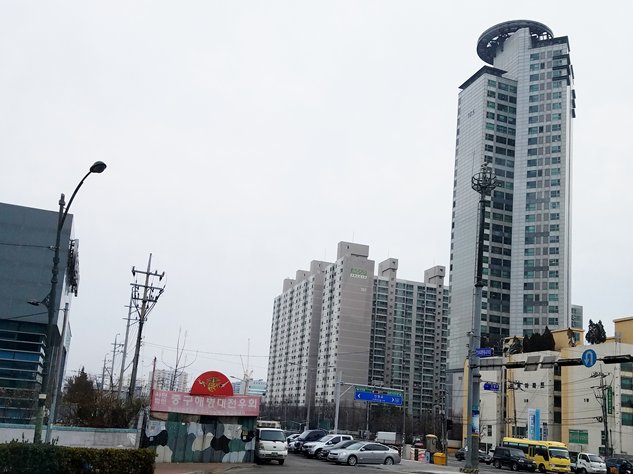
These are a few of the multitude of apartment houses between Incheon and Seoul.
The first day we visited Seoul we visited the Gyeonbokgung Palace, which used to house the royal family and the court. Given that on the outside they all look like the Palaces from Japan I will not post a photo of the outside. What I found beautiful was the top of the entrance. 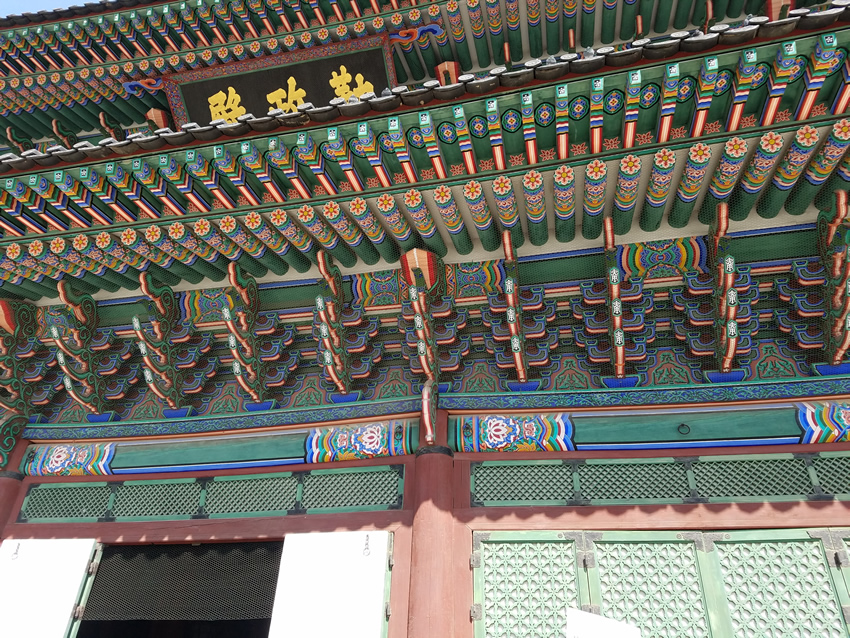
There are five colors, each represents a season. The center of the circles is yellow which color can only be worn by the emperor.
The are three paved paths leading to the palace. The center one was for the emperor ONLY. The right path was for the military and the left one for the civil servants. The common people, 93% of the population, were not permitted entry to the palace. The penalty for a non-emperor walking in the center path was death, not only for the transgressor, but for everyone in his or her family including parents, parents-in-law, aunts, uncles, cousins; in short wiping out an entire family. The interior of the castle is beautiful. The center part in the photo below contains the throne.

Girls in any area of the country between 4 and 10 years were eligible to apply to be court ladies. The requirements were beauty, intelligence and being a virgin. If a girl was 10 they had to test to see if she was a virgin. Not having access to modern anatomy their test involved the blood of a parrot. (No one seems to know why it was a parrot). A drop of parrot blood was placed on the young girl’s wrist. If it stayed on she was a virgin, but if it rolled off she was not. Once accepted the young girl had a 15-year apprenticeship in the work that was chosen for her. It could be cooking, cleaning or sewing. After 15 years, she was a court lady and collected a salary. She still continued working, but only every other day. Many of these women became quite wealthy.
The process for selecting a Queen was even more difficult. Girls from around the country could apply. The first test was for beauty: the forehead had to be high (measured of course), the eyebrows had to be a given distance apart, the nose could have no imperfections, and the chin a given length, plus of course, overall beauty. Those who met these criteria were given an intelligence test. If she passed that, she had a meal with the royal family so that her manners and proper family upbringing could be evaluated, plus an interview with members of the royal family. If she passed all these tests and was chosen she became Queen and married the King.
The emperor of course also had concubines. The Queen could not sleep with the King whenever she or he wanted, it had to be a perfect day, including the weather. If the signs were ok then it was ok and one hoped would produce an heir. Given all the conditions, it was not unusual for an heir to be produced by one of the concubines.
The Queen tended to become the royal scapegoat for anything that went wrong. Punishment was death for the Queen and her entire family, just like for those who dared to walk in the center path to the palace. Consequently, there were few applicants for Queen. The last time this contest was held there were only 27 applicants.
During the Japanese occupation, in their quest to “Japanize” the population, the heir to the Korean throne was forced to marry a Japanese princess. Because an heir so produced could not be accepted by the Koreans this was the end of the royal line. The last emperor died in 1986.
The traditional dress is still in the Korean psyche. For weddings the entire party rents these clothes for the occasion. Additionally, many young people, especially the girls, rent the dresses for $20 an hour and then have their pictures taken at the castle like those below who graciously assented to letting us take their pictures..

Because most of the famous buildings in Japan and Korea were of wood, fire destroyed many of them, however, they rebuilt them, sometimes more than once. This castle is no exception.
In the Folklore Museum where we went next, there were models of some typical Korean Homes, including one of an aristocrat, which had a tile roof, a rice farmer, and a farmer in a non-rice growing area. The one that I found the most interesting was the rice farmer's seen below.
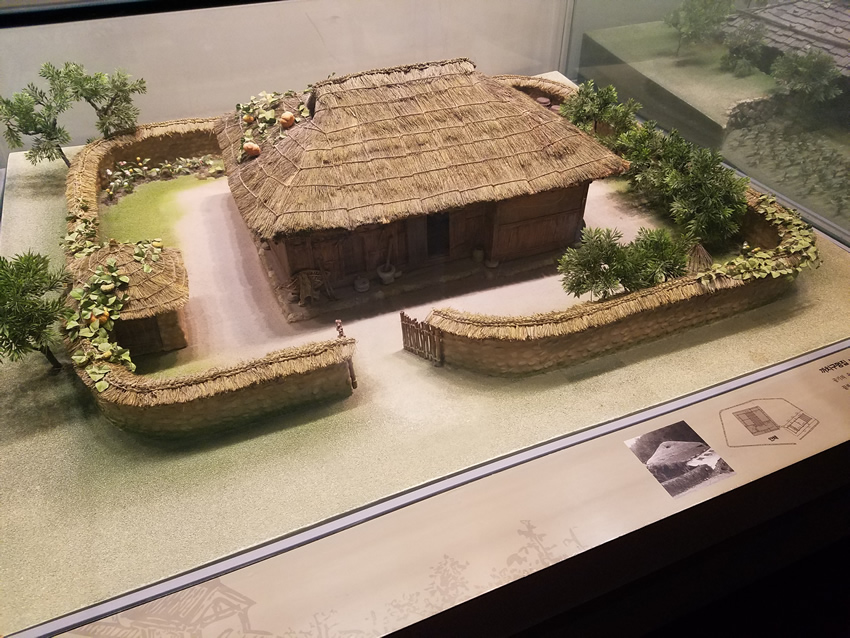
That roof is made of rice straw. It does keep out the weather, but has several problems. It attracts bugs, particularly in the winter because it is warmer than the outside. It also is only good for about a year, so must be replaced every year, no small amount of work. 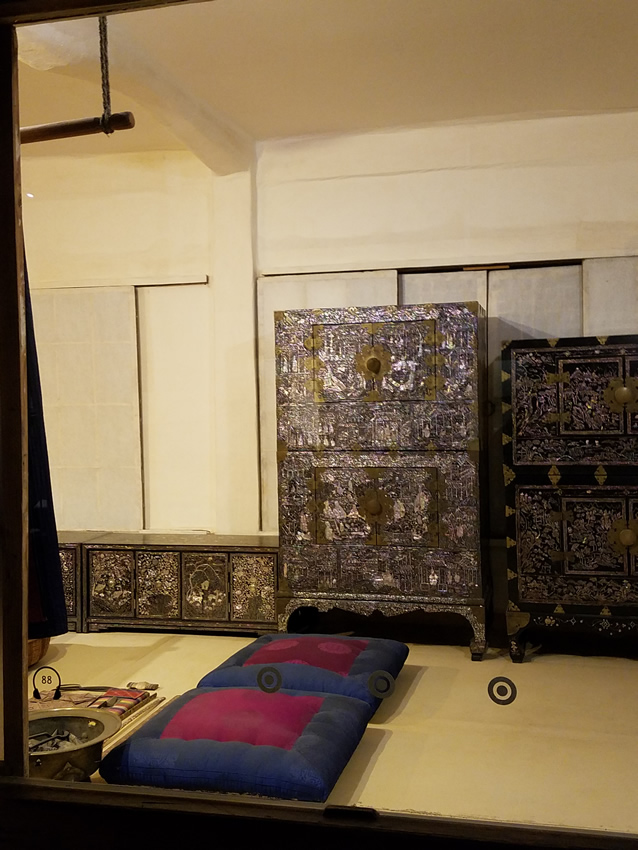
Males and females in the traditional homes in earlier times had separate living quarters. Women had the kitchen and a room of their own, the size and furnishings of which depended on the wealth of the family. Note the chests of inlaid mother of pearl.
Note the futon on the floor. This is because the heating is provided by "tunnels" from the kitchen stove which are under the floors. To prevent even more heat than usual in the summer, the cooking is done outside.
Besides cooking, ladies were expected to sew. Because the dyes used to color the clothes were not permanent, when washed they would bleed into other colors. Therefore, before washing each piece of clothing had to be disassembled, washed, dried, and then sewn back together again.
Isadong Street is a popular shopping street. Saturday it was thronged with South Koreans and half the ship! Some of the stores had inexpensive trinkets, others more expensive items.

Because our trip to Jeju Island had to be cancelled due to no safe mooring being available we had two days in Incheon. And on the spur of the moment another tour was organized for us on Sunday. It included a visit to the National Museum of Korea, the third most visited museum in Asia. To encourage families to visit there is no charge. We saw school children who as homework had to locate specific artifacts. Like the Japanese, the Koreans have a great reverence for their past.
Pottery on exhibit had examples of two types. On the vase on the left the design was carved into the vase and this painted. On the vase on the right side, cobalt was used to create a blue design. Cobalt was very expensive and had to be imported, hence was reserved for royalty.

The Koreans have a preference for fermented foods, such as kimchi. Today, in south Korea, they have special Kimchi refrigerators to provide the same conditions that burying the food achieved.The picture shows one type of kinchi - that made from cabbage. The first time that I saw it, I thought it was lasagna. Be careful, there are sometimes red peppers in it. When chili peppers were introduced to Asia, the Koreans took to them with gusto but the Japanese never adopted them.

At this museum we also saw a kimchi hut. I don’t think they were called that, but for lack of a better term… The hut was made of rice straw. Inside there is a hole in the ground where the kimchi was buried. Digging the hole is one job that men do.
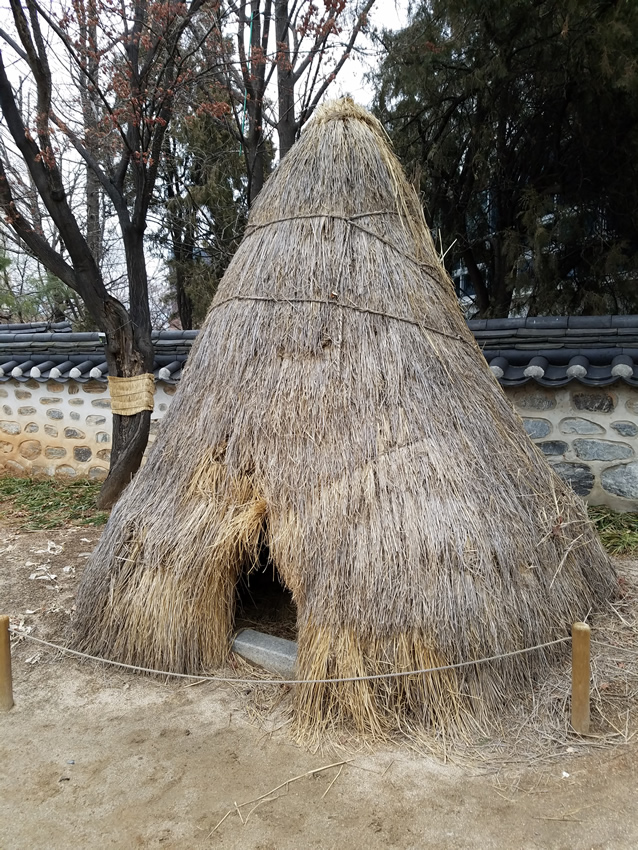
The museum had many statues of Buddhas. I learned that the position of the hands vary depending on what the Buddha is communicating. Unfortunately, I can’t remember them, but there is even one for medicine.
On to China…
Jeju (Cheju) Feb 20
Cancelled due to bad weather...This is what happens when you travel in the winter. Instead we had an extra day in Incheon. A colleague on the trip who has been there said that in the summer it is lovely, but in the winter barren. Guess we did not miss much, but I would love to return in the summer. It is referred to as the Korean Hawaii and is a location for honeymoons.
